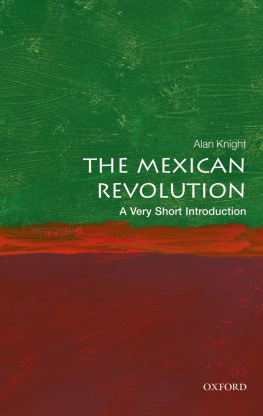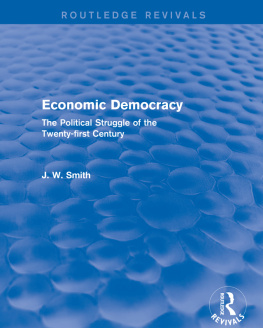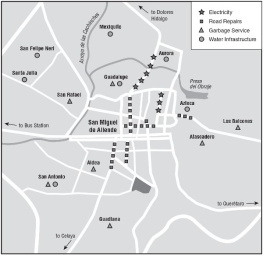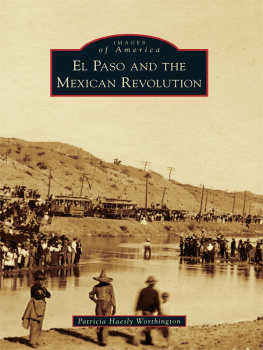Library of Congress
Cataloging-in-Publication Data
Centeno, Miguel ngel, 1957
Democracy within reason : technocratic revolution in Mexico / Miguel ngel Centeno.2nd ed.
p. cm.
Includes bibliographical references and index.
ISBN 0-271-01701-5
1. MexicoPolitics and government1988
2. Salinas de Gortari, Carlos.
3. Government executivesMexico.
4. Political leadershipMexico.
I. Title. F1236.C46 1997
320.972dc21 96-47836
CIP
Second printing, 1999
Copyright 1994
The Pennsylvania State University
Second edition copyright 1997
The Pennsylvania State University
All rights reserved
Printed in the United States of America
Published by
The Pennsylvania State University Press,
University Park, PA 16802-1003
Para Ta Ana, con todo mi cario.
Answers are enticing. Often it makes no difference whether an answer is right or wrong, as long as one exists. The more precise and decisive, the better; all the more so if the problem is complex. I remember my enchantment with linear programming during my first year in business school. One could enter as many variables as necessary, assign appropriate prices, choose what to maximize or minimize, write a few lines of instructions, and magically the most intricate management problem was reduced to a single quantity. The tools of modern management and economic analysis could dispel doubt, calm anxiety, and guarantee efficiency.
After my initial fascination I started wondering who chose what to maximize or minimize. As in Douglas Adamss novels, the significance of the answer 42 depends on the question. It was only after starting graduate school that I realized that power was not about producing solutions but about which questions were posed and how answers were verified. While studying the debt crisis in Latin America, for example, I read that populist policies were not viable and that proposals to share the costs of the crisis were clearly demagogic. What was important was responsibility, realistic appraisals, and truly feasible solutions. But, responsible to whom? Feasible for what? I found it difficult to accept that all these requirements coincidentally shifted most of the sacrifice toward the poor. Why would the debtor countries be so willing to take on such a burden? With all the talk of free riders in contemporary academic parlance, it struck me that the Latin American debtors behaved quite irrationally in paying their bills.
Perhaps the leaders of these countries were simply stooges of international finance? Having met many of those on Wall Street who supposedly had concocted this complex conspiracy, however, I found it difficult to believe that they had the intelligence or the skills to do so. The key to the new dependency of the debt was not the circulation of capital or commodities but the flow of knowledge. Those policy makers who had decided to pay back the debt, no matter the cost, simply could not imagine challenging the dictates of a model of international behavior. Much like medieval Ptolemists constructing evermore complex corollaries to explain the distance between theory and observation, the financial experts in both creditor and debtor countries tried to shape the world to meet their own expectations. As long as one asked the right questions, the model would work.
This book began as a study of the men and women who came up with these answers, the means by which they achieved power, and the consequences for their countries. While searching for a case study with which to examine financial policy making, I was struck by the particular characteristics of the Mexican state. Among the leaderships of regimes that could be loosely classified as bureaucratic-authoritarian, the Mexican elite was unique in that it achieved power without the apparent assistance of the military. How was it possible that these men and women, with no popular support, little or no charisma, and no military allies had been able to impose a regime of sacrifice? Who were these people and what was their vision of Mexico? Large parts of this book were written in order to answer these questions.
At the time I thought the answer would only be of historical interest since the Mexican technocrats would not remain in power for long. Like many others I thought that I had witnessed the last gasp of the Mexican regime in 1988. Whether Carlos Salinas had managed to win or steal the presidency did not matter since the regime was obviously on its last legs. In a proposal I wrote late in 1988 I mentioned that, unlike the Communist Party of the Soviet Union, the PRI did not have the resources to stay in power and that Salinas, unlike Mikhail Gorbachev, could not expect to survive while undermining his own political base.
Four years later and not quite so certain of my predictive powers, I arrived in Moscow to teach Russian students about the Mexican version of perestroika. From the Russian perspective the Mexican model could appear quite attractive. Among the ruins of one absolute dogma many sought yet another model, equally perfect in its logical closure. The new Mexican miracle certainly compared favorably to the chaos and uncertainty of the Russian transition. If one defined success as the ability to remain in power while overseeing radical social change, the achievements of the Mexican regime were truly outstanding. The trick was in the definition of success. Given the right question, Mexico seemed the perfect answer.
One obvious question was whether glasnost had doomed perestroika. Many Russians appeared to think so. In Moscow I often heard that perhaps Russia could not afford democracy. Democracy was fine, but perhaps it should be momentarily delayed. Russians should once again wait for the withering of the state. To some, Salinas seemed a smarter version of Gorbachev, having focused on the economy before democracy. I was struck by how easy it was to see democratic procedures as an unaffordable luxury and how the willingness of a population to express anger at suffering and declining standards of living could be seen as an obstacle to needed change. Russians were not alone in this opinion. The assumption in much of the academic literature was that reasonable solutions required reasonable governments, and democracies had an unfortunate habit of producing quite unreasonable results. Democracy was a perfectly respectable objective, but only within reason.
If this book reflects my biases (and undoubtedly it does), one is clear and explicit: a preference for democracy over wisdom. Contemporary Moscow is one obvious example of what happens when an elite vanguard insists on the inevitability of its model. Both the now-discredited Leninist model and the fashionable technocratic alternative share the same distrust of their own population and the same inflated sense of their own virtue. That the Salinas government has produced almost miraculous results is indisputable, but Moscow, in its time, was also said to represent the future. Precisely because it appears to represent such a wonderful solution, a perfect answer to those who seek a way to make a leap into modernity, it is important to understand the origins, characteristics, potential, and limitations of the Mexican model. This book is an attempt to define these.
The book is not an attempt to defend democracy since I believe it is impossible to do so except on its own terms. If the question of the transition to the market is posed in terms of effectiveness, stability, and speed, the answer will most likely be authoritarian. The advantages of not having to worry about opposition when imposing unpopular policies do not need belaboring. The ability of an all-powerful state to create economic miracles was more than adequately proven in both Germany and the Soviet Union in the 1930s; the potential costs were also made patently clear. Rather, the book is concerned with the specific organization, personnel, and doctrine of the Mexican technocratic state and the relationship between these and specific policy choices. It is about who asked what questions and how their answers shaped Mexicos response to the revolution of the market in the 1980s.







